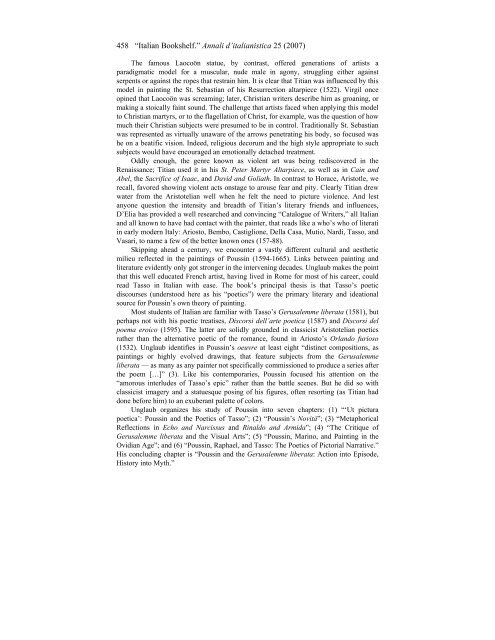Italian Bookshelf (download as PDF) - Ibiblio
Italian Bookshelf (download as PDF) - Ibiblio
Italian Bookshelf (download as PDF) - Ibiblio
You also want an ePaper? Increase the reach of your titles
YUMPU automatically turns print PDFs into web optimized ePapers that Google loves.
458 “<strong>Italian</strong> <strong>Bookshelf</strong>.” Annali d’italianistica 25 (2007)<br />
The famous Laocoön statue, by contr<strong>as</strong>t, offered generations of artists a<br />
paradigmatic model for a muscular, nude male in agony, struggling either against<br />
serpents or against the ropes that restrain him. It is clear that Titian w<strong>as</strong> influenced by this<br />
model in painting the St. Seb<strong>as</strong>tian of his Resurrection altarpiece (1522). Virgil once<br />
opined that Laocoön w<strong>as</strong> screaming; later, Christian writers describe him <strong>as</strong> groaning, or<br />
making a stoically faint sound. The challenge that artists faced when applying this model<br />
to Christian martyrs, or to the flagellation of Christ, for example, w<strong>as</strong> the question of how<br />
much their Christian subjects were presumed to be in control. Traditionally St. Seb<strong>as</strong>tian<br />
w<strong>as</strong> represented <strong>as</strong> virtually unaware of the arrows penetrating his body, so focused w<strong>as</strong><br />
he on a beatific vision. Indeed, religious decorum and the high style appropriate to such<br />
subjects would have encouraged an emotionally detached treatment.<br />
Oddly enough, the genre known <strong>as</strong> violent art w<strong>as</strong> being rediscovered in the<br />
Renaissance; Titian used it in his St. Peter Martyr Altarpiece, <strong>as</strong> well <strong>as</strong> in Cain and<br />
Abel, the Sacrifice of Isaac, and David and Goliath. In contr<strong>as</strong>t to Horace, Aristotle, we<br />
recall, favored showing violent acts onstage to arouse fear and pity. Clearly Titian drew<br />
water from the Aristotelian well when he felt the need to picture violence. And lest<br />
anyone question the intensity and breadth of Titian’s literary friends and influences,<br />
D’Elia h<strong>as</strong> provided a well researched and convincing “Catalogue of Writers,” all <strong>Italian</strong><br />
and all known to have had contact with the painter, that reads like a who’s who of literati<br />
in early modern Italy: Ariosto, Bembo, C<strong>as</strong>tiglione, Della C<strong>as</strong>a, Mutio, Nardi, T<strong>as</strong>so, and<br />
V<strong>as</strong>ari, to name a few of the better known ones (157-88).<br />
Skipping ahead a century, we encounter a v<strong>as</strong>tly different cultural and aesthetic<br />
milieu reflected in the paintings of Poussin (1594-1665). Links between painting and<br />
literature evidently only got stronger in the intervening decades. Unglaub makes the point<br />
that this well educated French artist, having lived in Rome for most of his career, could<br />
read T<strong>as</strong>so in <strong>Italian</strong> with e<strong>as</strong>e. The book’s principal thesis is that T<strong>as</strong>so’s poetic<br />
discourses (understood here <strong>as</strong> his “poetics”) were the primary literary and ideational<br />
source for Poussin’s own theory of painting.<br />
Most students of <strong>Italian</strong> are familiar with T<strong>as</strong>so’s Gerusalemme liberata (1581), but<br />
perhaps not with his poetic treatises, Discorsi dell’arte poetica (1587) and Discorsi del<br />
poema eroico (1595). The latter are solidly grounded in cl<strong>as</strong>sicist Aristotelian poetics<br />
rather than the alternative poetic of the romance, found in Ariosto’s Orlando furioso<br />
(1532). Unglaub identifies in Poussin’s oeuvre at le<strong>as</strong>t eight “distinct compositions, <strong>as</strong><br />
paintings or highly evolved drawings, that feature subjects from the Gerusalemme<br />
liberata — <strong>as</strong> many <strong>as</strong> any painter not specifically commissioned to produce a series after<br />
the poem […]” (3). Like his contemporaries, Poussin focused his attention on the<br />
“amorous interludes of T<strong>as</strong>so’s epic” rather than the battle scenes. But he did so with<br />
cl<strong>as</strong>sicist imagery and a statuesque posing of his figures, often resorting (<strong>as</strong> Titian had<br />
done before him) to an exuberant palette of colors.<br />
Unglaub organizes his study of Poussin into seven chapters: (1) “‘Ut pictura<br />
poetica’: Poussin and the Poetics of T<strong>as</strong>so”; (2) “Poussin’s Novità”; (3) “Metaphorical<br />
Reflections in Echo and Narcissus and Rinaldo and Armida”; (4) “The Critique of<br />
Gerusalemme liberata and the Visual Arts”; (5) “Poussin, Marino, and Painting in the<br />
Ovidian Age”; and (6) “Poussin, Raphael, and T<strong>as</strong>so: The Poetics of Pictorial Narrative.”<br />
His concluding chapter is “Poussin and the Gerusalemme liberata: Action into Episode,<br />
History into Myth.”

















